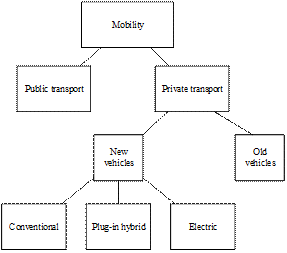Transport - GEM-E3: Difference between revisions
Jump to navigation
Jump to search
No edit summary |
No edit summary |
||
| Line 35: | Line 35: | ||
{| class="wikitable" | {| class="wikitable" | ||
|width="5%" |No | |width="5%" |"No" | ||
|width=" | |width="20%" |"Sector" | ||
|width="5%" |No | |width="5%" |"No" | ||
|width=" | |width="20%" |"Sector" | ||
|- | |- | ||
|1 | |1 | ||
Revision as of 12:50, 21 October 2016
| Corresponding documentation | |
|---|---|
| Previous versions | |
| Model information | |
| Model link | |
| Institution | Institute of Communication And Computer Systems (ICCS), Greece, https://www.iccs.gr/en/. |
| Solution concept | General equilibrium (closed economy) |
| Solution method | Optimization |
| Anticipation | |
Table 6: Regional coverage of the GEM-E3T model
| Country/Region |
|---|
| EU-28 Member States individually |
| USA |
| Japan |
| Canada |
| Brazil |
| China |
| India |
| Oceania |
| Russian Federation |
| Rest of Annex I |
| Rest of the world |
Table 7: Sectoral coverage of the GEM-E3T model
| "No" | "Sector" | "No" | "Sector" |
| 1 | Agriculture (other than wheat, cereal grains, etc. and oil seeds) | 16 | Other equipment goods |
| 2 | Wheat, cereal grains, sugar cane, sugar beet | 17 | Consumer goods industries |
| 3 | Oil seeds | 18 | Construction |
| 4 | Coal | 19 | Transport (Air) |
| 5 | Crude oil | 20 | Transport (Road-Freight) |
| 6 | Oil refinery (excluding blending of biofuels) | 21 | Transport (Road -Passenger) |
| 7 | Gas | 22 | Transport (Rail -Freight) |
| 8 | Electricity supply | 23 | Transport (Rail -Passenger) |
| 9 | Ferrous metals | 24 | Transport (Water - Freight) |
| 10 | Non-ferrous metals | 25 | Transport (Water - Passenger) |
| 11 | Chemical products | 26 | Market services |
| 12 | Paper products | 27 | Non-market services |
| 13 | Non-metallic minerals | 28 | Bio-gasoline, ethanol |
| 14 | Electric goods | 29 | Bio-diesel |
| 15 | Transport equipment (excluding electric vehicles) | 30 | Electric vehicles |
Figure 13: Upper levels of the nesting scheme in production functions of business sectors
File:Figure 13 Upper levels of the nesting scheme in production functions of business sectors.gif
Figure 14: Nesting scheme for the choice of transport modes in production functions of business sectors
Table 8: Categories of consumption by purpose in GEM-E3T
| No | Categories |
|---|---|
| 1 | Food, beverages and tobacco |
| 2 | Clothing and footwear |
| 3 | Housing and water charges |
| 4 | Households equipment and operation (excl. heating and cooking appliances) |
| 5 | Medical care and health |
| 6 | Communication |
| 7 | Recreational services |
| 8 | Miscellaneous goods and services |
| 9 | Education |
| 10 | Mobility |
| 11 | Heating, cooling, water heating and cooking |
| 12 | Electric appliances |
Figure 15: Households’ transport demand nesting scheme
Table 9: Interface protocol between PRIMES-TREMOVE and GEM-E3T
| Inputs from PRIMES-TREMOVE | How they are reflected in GEM-E3T |
|---|---|
| 1. Projection of passenger and freight transport activity and modal choices | Calibration of scale and share parameters of production functions and household consumption functions of GEM-E3T to derive similar demand for transport services |
| 2. Cost elements of various transport technologies (e.g. electric cars) and their dynamic evolution | Use of the same cost elements in GEM-E3T and calibration of the technology learning functions to reproduce the same dynamic evolution of costs |
| 3. Energy efficiency improvement of transport means | Calibration of parameters expressing productivity of energy use in transport supply sectors and similarly parameters relating consumption of fuels by transport durable goods used by households |
| 4. Additional costs related to improvements in energy efficiency | Modification of unit costs in transport service supply sectors and for durable goods used by households |
| 5. CO2 or energy performance standards on manufacturers of vehicle | Change of the values of parameters expressing preferences in the choice of vehicle technology type to shift away from technologies which do not comply with standards |
| 6. Use of biofuels in certain transport modes and projection of production of advanced biofuels | Change of parameter values used in the production and consumption functions which concern choice of fuel type. Modification of parameters of production functions modelling agricultural feedstock, as well as production and blending of biofuels in the refinery sector. |
| 7. Changes in consumption of electricity in transport combined with decarbonisation in power generation | Demand for electricity for transport is calibrated by modifying parameter values influencing fuel choice in production and consumption functions. Decarbonisation of power generation is represented in the respective equations of GEM-E3T by modifying fuel mix, investment and costs. |
| 8. Taxation and subsidies | Use of the same values for taxation of fuels and subsidies |
| 9. Infrastructure | Incorporation of costs of developing the infrastructure. Modification of productivity parameters in certain production functions to reflect effects of infrastructure. The influence of availability of recharging infrastructure on generalised costs of transport is aligned to the values used in PRIMES-TREMOVE. |

